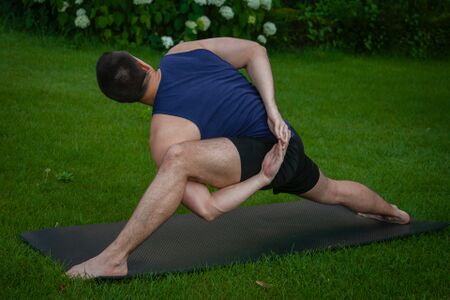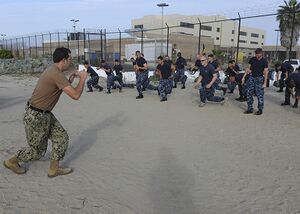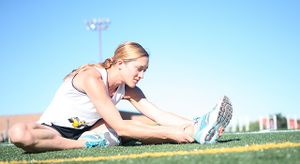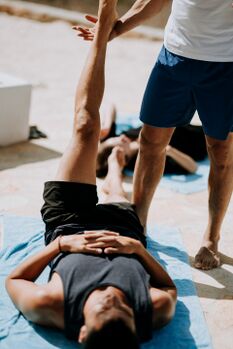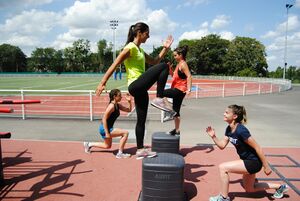Flexibility
Original Editor - Lucinda hampton
Top Contributors - Lucinda hampton, Anne Dixie Lim and Aminat Abolade
Introduction[edit | edit source]
Flexibility refers to the ability of muscles, joints, and soft tissues to move through an unrestricted, pain-free range of motion. It involves the capacity of these structures to stretch, lengthen, and contract without limitations, allowing for smooth and efficient movement.
Having adequate flexibility can enhance athletic performance, reduce the risk of musculoskeletal injuries, and improve overall quality of life. Although flexibility varies widely from person to person, minimum ranges are necessary for maintaining joint and total body health. Many variables affect the loss of normal joint flexibility, including genetics, age, activity levels, and previous injuries. The range of motion will be influenced by the mobility of the soft tissues that surround the joint, including muscles, ligaments, tendons, joint capsules, and skin. A lack of stretching, especially when combined with activity, can lead to fatigue-induced soft tissue shortening over time.[1]
Assessment[edit | edit source]
Flexibility can be assessed using various methods depending on the specific joints or muscle groups being evaluated. Here are some common techniques for assessing flexibility. Some of the test-retest reliability of these tests is consistently high, but validity ranges from low to moderate depending on the criterion used.[2]
Laboratory Tests[edit | edit source]
- Flexibility assessments are often done using goniometers, which are devices used to measure the angle of joints or their range of motion. Goniometers typically consist of a body resembling a protractor with two thin extensions called arms - a stationary arm and a moving arm. The examiner places the goniometer along the bone near the joint being measured to determine the range of motion.
- The Schober test is a specific method used to assess lumbar spine flexibility. It is commonly used as a quick and simple way to assess lumbar spine mobility.
Functional Movement Assessments[edit | edit source]
- The shoulder stretch (or Apley's scratch test) involves reaching over and behind the shoulder with one hand while reaching behind and upward the back with the other hand, and measuring the distance between the hands or overlap.
- The trunk lift (or prone on hand) assesses both muscle strength and flexibility by measuring the height of the chin from the floor when lifting the upper body off the floor.
- Sit-and-reach tests (or toe touch test), where a person flexes the hip to touch their toes, are popular for assessing low-back and hamstring flexibility. These tests can be done bilaterally or unilaterally, with measurements taken in inches or centimeters using measuring lines or rulers.
- Weight-Bearing Lunge Test (or knee to wall test) was used to assess ankle dorsiflexion range of motion, with participants standing barefoot in front of a wall and moving one leg back and then lunging forward with the front knee toward the wall. The maximal distance from the toe to the wall was measured.
- Straight Leg Raise Test was used to assess hamstring flexibility, with participants in a supine position on a massage table and raising their leg with the knee fully extended and the pelvis in a neutral position. The hip angle during flexion was measured, and the best performance was recorded as the maximal range of motion.[3]
Importance of Flexibility[edit | edit source]
Inadequate flexibility will have a negative effect on the body in 3 significant ways:
- Joints require movement through a full range of motion to maintain the health of cartilage and other structures within the joint (e.g. Synovium).
- Muscles that are inflexible tire more quickly, causing opposing muscle groups to work harder. Muscle fatigue can lead to muscular injuries and the inability of the muscles to protect joints from more severe injuries. eg the hamstrings play a role in stabilizing the knee and preventing ACL tears.
- Decreased flexibility may also lead to abnormal stress on structures and tissues distant from the initial site of inflexibility. eg tendonitis in the knee can be related to calf tightness.
Exercise Recommendations[edit | edit source]
There are several different types of exercises that can be done to enhance flexibility, including the following:
- Stretching increases muscle length and reduces muscle stiffness, leading to improved flexibility and joint mobility.[2]
- Joint mobilization can improve joint mobility, relieve joint stiffness, and increase joint range of motion.[4]
- Myofascial release or soft tissue release can improve flexibility by releasing tension in the fascia and muscles, improving tissue mobility, and enhancing range of motion.[3]
- Strength training can improve flexibility by addressing muscle weakness, increasing muscle strength, and enhancing joint stability, which can result in improved range of motion and mobility.[5]
Dynamic VS Static Stretches[edit | edit source]
When preparing the muscles for action, eg swimming, running, you need to prepare your muscles with a warm ups that typically include stretching. So the question arises which gives better results static or dynamic stretches?
The stretching portion traditionally incorporated static stretching. However, there are a myriad of studies demonstrating static stretch-induced performance impairments. More recently, there are a substantial number of articles with no detrimental effects associated with prior static stretching.[6]
- Dynamic stretching improves repeated-sprint performance to a greater extent than static stretching and no stretching.[7]
- Immediately after a single bout of static stretching significant reductions in maximal voluntary strength, muscle power or evoked contractile properties have been recorded.[8]
- Active warm-ups encompassing such exercises as sprints and plyometrics can enhance power and strength performance. Meanwhile shorter, static stretching not only fails to provide such a boost, but may also reduce strength.[9]
- A meta-analysis of 32 studies on warming up and performance in 2010 also found that doing an active warm-up before engaging in sports yields improved performance, in this case, by 79 percent across all criteria examined.[9]
Older People[edit | edit source]
Flexibility training interventions in older adults are often effective at increasing joint range of motion in various joints, and various functional outcomes can be improved. However older adults are not overly concerned with high performance benefits from increased flexibility and more focused on being safely active and safely performing activities of daily living. Injury and fall prevention are also common motives for recommending flexibility programs to older adults. Flexibility training may enhance postural stability and balance when combined with resistance training.[10] (See also Physical Activity in Older Adults)
While there is a lack of evidence to recommend stretching routines outside of a rehabilitative context, there is no additional health or functional risk of including flexibility exercises. In light of increases in functional outcomes achieved by other exercise modes (balance, aerobic exercise, and strengthening exercises), stretching exercises can be included as an adjunct to the above, but the current literature would indicate it would add little to the functional benefits of the other exercise modes.[10]
Low Back Pain[edit | edit source]
Flexibility exercises are often used in exercise rehabilitation programmes as they have been shown to be effective at reducing the pain associated with non-specific chronic low back pain. (See also Interventions for LBP)
Stretching the soft tissues in the back, legs and buttock eg hamstrings, erector muscles of the spine and hip flexor muscles, ligaments and tendons can help to mobilise the spine, and an increase in the range of motion of the spine can reduce back pain. This is because stretching can improve the flexibility of the muscle-tendons and ligaments in the back, which is important to increase the range of motion of the joints. This improved range of motion assists with patients’ movement and ability to complete activities of daily living, as most everyday tasks such as lifting and bending require trunk flexion, which involves a complex movement combining lumbar and hip motion.[11]
Conclusion[edit | edit source]
Flexibility exercises are recommended as part of a complete exercise program along with aerobic exercise, resistance training, and neuromotor exercise training.
- Chronic improvements in ROM are possible with a regular stretching program, concerns have been raised related to the acute impact of static stretching on subsequent strength and power performance. Dynamic stretches are a good option.
- As yet not definitive but shifting static stretching exercises from preactivity to postactivity may be an option to consider, or including flexibility exercises as a stand-alone program to reap the benefits of chronic adaptations.[2]
References[edit | edit source]
- ↑ UC Davis health What is flexibility Available: https://health.ucdavis.edu/sportsmedicine/resources/flexibility_descriprion.html(accessed 25.12.2021)
- ↑ 2.0 2.1 2.2 Health and fitness journal Flexibility Exercises and Performance Available: https://journals.lww.com/acsm-healthfitness/Fulltext/2016/09000/Flexibility_Exercises_and_Performance.4.aspx(accessed 24.12.2021)
- ↑ 3.0 3.1 Zhang Q, Trama R, Fouré A, Hautier CA. The Immediate Effects of Self-Myofacial Release on Flexibility, Jump Performance and Dynamic Balance Ability. J Hum Kinet. 2020;75:139-48.
- ↑ Kaminski TW, Kahanov L, Kato M. Therapeutic Effect of Joint Mobilization: Joint Mechanoreceptors and Nociceptors. Athletic Therapy Today. 2007;12(4):28-31.
- ↑ Afonso J, Ramirez-Campillo R, Moscão J, Rocha T, Zacca R, Martins A, et al. Strength Training versus Stretching for Improving Range of Motion: A Systematic Review and Meta-Analysis. Healthcare (Basel). 2021;9(4).
- ↑ Behm DG, Chaouachi A. A review of the acute effects of static and dynamic stretching on performance. European journal of applied physiology. 2011 Nov;111(11):2633-51.Available:https://www.researchgate.net/publication/50272304_A_review_of_the_acute_effects_of_static_and_dynamic_stretching_on_performance (accessed 24.12.2021)
- ↑ Zmijewski P, Lipinska P, Czajkowska A, Mróz A, Kapuściński P, Mazurek K. Acute Effects of a Static Vs. a Dynamic Stretching Warm-up on Repeated-Sprint Performance in Female Handball Players. Journal of human kinetics. 2020 Mar;72:161.Available:https://www.ncbi.nlm.nih.gov/pmc/articles/PMC7126248/ (accessed 24.12.2021)
- ↑ Opplert J, Babault N. Acute effects of dynamic stretching on muscle flexibility and performance: an analysis of the current literature. Sports Medicine. 2018 Feb;48(2):299-325.Available: https://pubmed.ncbi.nlm.nih.gov/29063454/ (accessed 24.12.2021)
- ↑ 9.0 9.1 Open fit Dynamic vs Static stretching Available: https://www.openfit.com/dynamic-vs-static-stretching-warm-up-exercises(accessed 24.12.2021)
- ↑ 10.0 10.1 Stathokostas L, Little R, Vandervoort AA, Paterson DH. Flexibility training and functional ability in older adults: a systematic review. Journal of aging research. 2012 Nov 8;2012.Available:https://www.ncbi.nlm.nih.gov/pmc/articles/PMC3503322/ (accessed25.12.2021)
- ↑ Gordon R, Bloxham S. A systematic review of the effects of exercise and physical activity on non-specific chronic low back pain. InHealthcare 2016 Jun (Vol. 4, No. 2, p. 22). Multidisciplinary Digital Publishing Institute. Available: https://www.ncbi.nlm.nih.gov/pmc/articles/PMC4934575/(accessed 25.12.2021)
